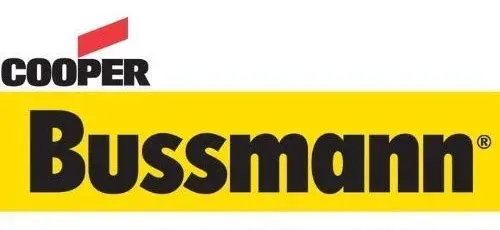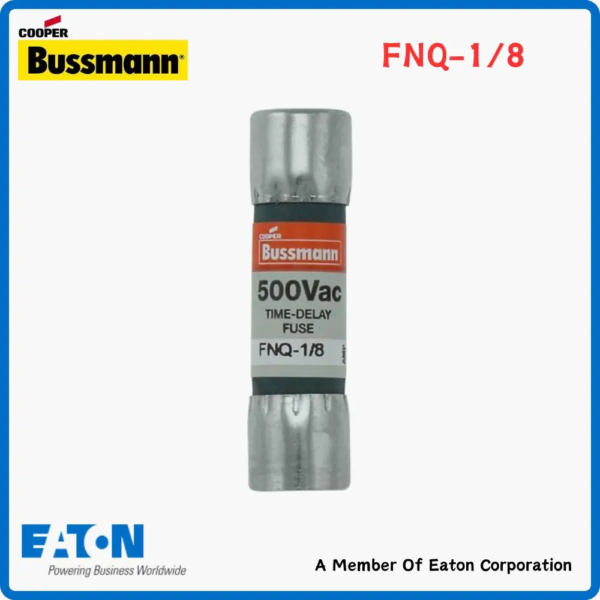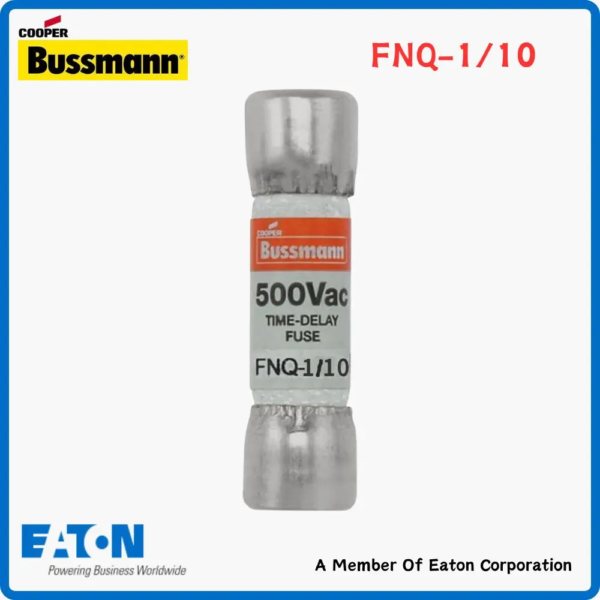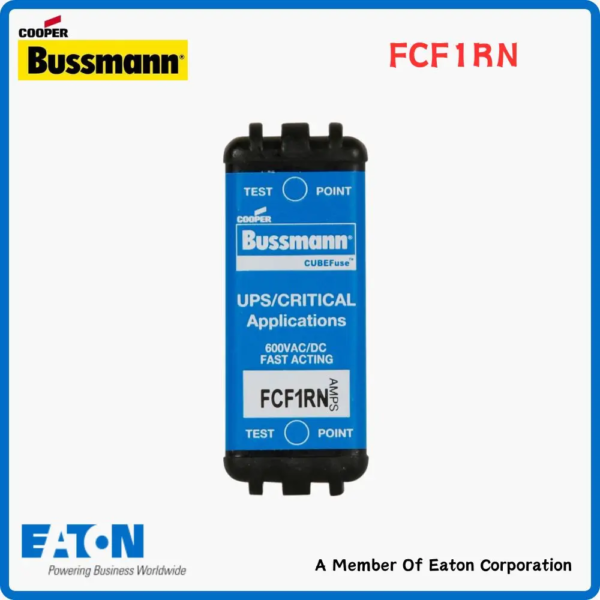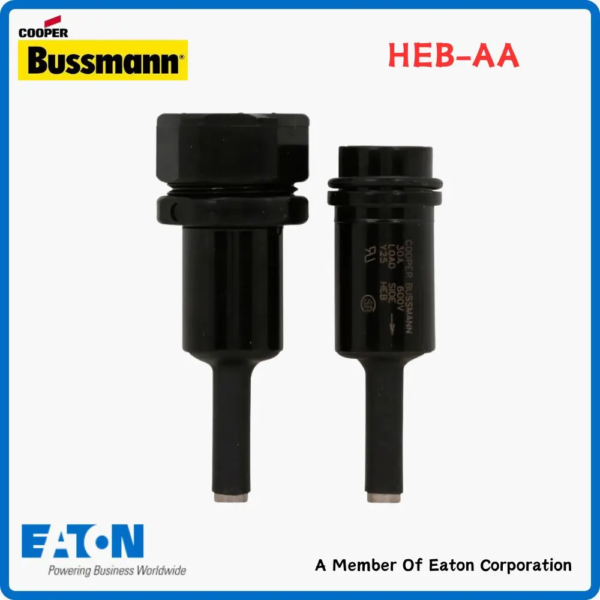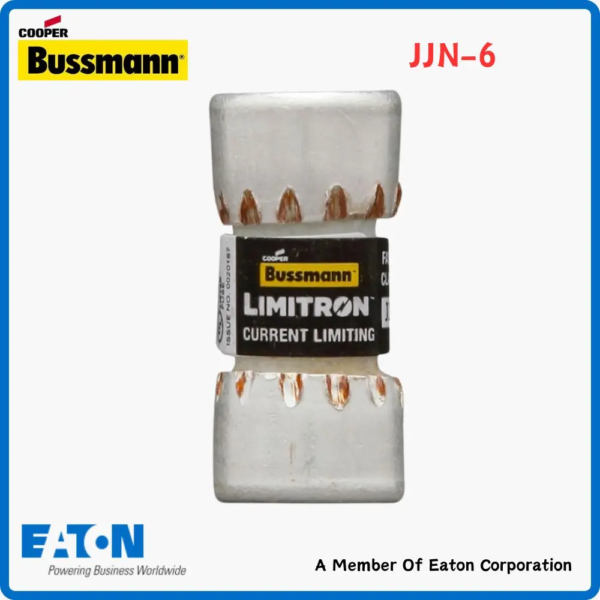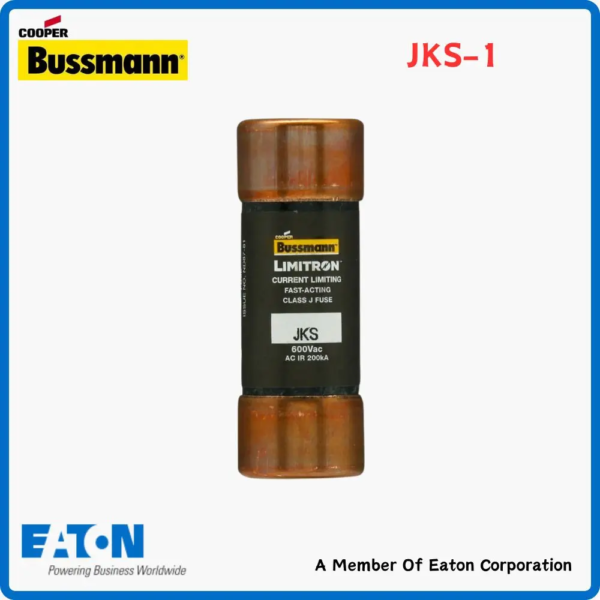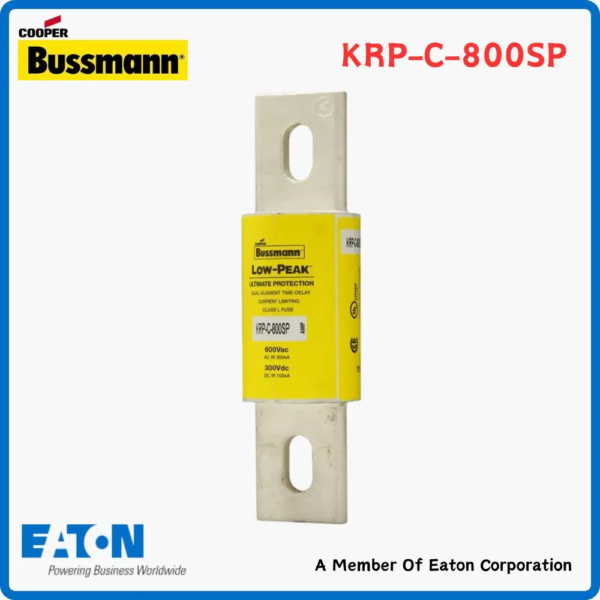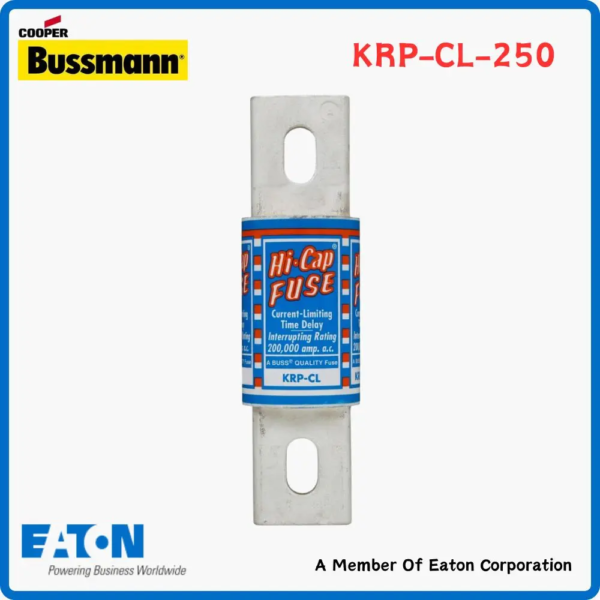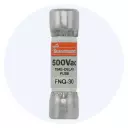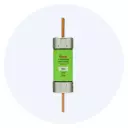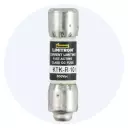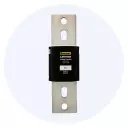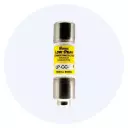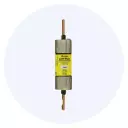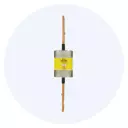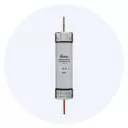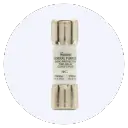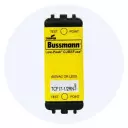Bussmann FNQ Fuses
“Eaton Bussmann FNQ-R-1/10 Low Voltage Fuse” has been added to your cart. View cartEaton Bussmann FNQ-1/8 Low Voltage Fuse
Rated 5.00 out of 5In stock
$16.74EachSKU: FNQ-1/8Weight 0.175 lbs Dimensions 0.01138889 × 0.01138889 × 0.04166667 yd Brand Eaton Bussmann
Eaton-Bussmann, with its headquarters in St. Louis, Missouri, is a division of Eaton Corporation that specializes in the production of circuit protection products. These products are designed for use in the electrical, electronic, and automotive industries, both domestically and on a global scale. The company boasts a strong manufacturing network with facilities located in three domestic and six international locations, reflecting its commitment to serving customers worldwide. With a team of approximately 3,000 employees, Eaton-Bussmann is well-positioned to meet the ever-evolving needs of its customers in the electrical protection industry.
Eaton stands as a forward-thinking leader in power management, focused on enhancing lifestyles and safeguarding the planet. Leveraging the worldwide momentum of electrification and digital innovation, they propel the global shift towards renewable energy, addressing pressing power management issues on a global scale.Product type Low Voltage Fuse
Voltage 500 Volt
Eaton Bussmann FNQ-R-1/10 Low Voltage Fuse
Rated 5.00 out of 5In stock
$11.33EachSKU: FNQ-R-1/10Weight 0.175 lbs Dimensions 0.01138889 × 0.01138889 × 0.04166667 yd Brand Eaton Bussmann
Eaton-Bussmann, with its headquarters in St. Louis, Missouri, is a division of Eaton Corporation that specializes in the production of circuit protection products. These products are designed for use in the electrical, electronic, and automotive industries, both domestically and on a global scale. The company boasts a strong manufacturing network with facilities located in three domestic and six international locations, reflecting its commitment to serving customers worldwide. With a team of approximately 3,000 employees, Eaton-Bussmann is well-positioned to meet the ever-evolving needs of its customers in the electrical protection industry.
Eaton stands as a forward-thinking leader in power management, focused on enhancing lifestyles and safeguarding the planet. Leveraging the worldwide momentum of electrification and digital innovation, they propel the global shift towards renewable energy, addressing pressing power management issues on a global scale.Product type Low Voltage Fuse
Voltage 500 Volt
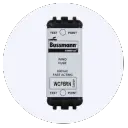 Bussmann WCF Fuses
Bussmann WCF Fuses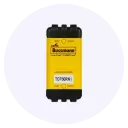 Bussmann FCF Fuses
Bussmann FCF Fuses
Eaton Bussmann Series UL Class CF, FCF 1RN Fuse
Rated 5.00 out of 5In stock
$79.99SKU: FCF1RNBrand Eaton Bussmann
Eaton-Bussmann, with its headquarters in St. Louis, Missouri, is a division of Eaton Corporation that specializes in the production of circuit protection products. These products are designed for use in the electrical, electronic, and automotive industries, both domestically and on a global scale. The company boasts a strong manufacturing network with facilities located in three domestic and six international locations, reflecting its commitment to serving customers worldwide. With a team of approximately 3,000 employees, Eaton-Bussmann is well-positioned to meet the ever-evolving needs of its customers in the electrical protection industry.
Eaton stands as a forward-thinking leader in power management, focused on enhancing lifestyles and safeguarding the planet. Leveraging the worldwide momentum of electrification and digital innovation, they propel the global shift towards renewable energy, addressing pressing power management issues on a global scale.Product type Fuse
Voltage 600 Volt
 Bussmann FRS Fuses
Bussmann FRS Fuses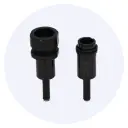 Bussmann HEB-AA Fuse
Bussmann HEB-AA Fuse
Eaton Bussmann HEB-AA Inline Fuse Holder
Rated 5.00 out of 5In stock
$18.99SKU: 504-HEB-AA-2Brand Eaton Bussmann
Eaton-Bussmann, with its headquarters in St. Louis, Missouri, is a division of Eaton Corporation that specializes in the production of circuit protection products. These products are designed for use in the electrical, electronic, and automotive industries, both domestically and on a global scale. The company boasts a strong manufacturing network with facilities located in three domestic and six international locations, reflecting its commitment to serving customers worldwide. With a team of approximately 3,000 employees, Eaton-Bussmann is well-positioned to meet the ever-evolving needs of its customers in the electrical protection industry.
Eaton stands as a forward-thinking leader in power management, focused on enhancing lifestyles and safeguarding the planet. Leveraging the worldwide momentum of electrification and digital innovation, they propel the global shift towards renewable energy, addressing pressing power management issues on a global scale.Product type Fuse
Voltage 600 Volt
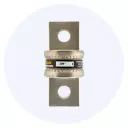 Bussmann JJN Fuses
Bussmann JJN Fuses
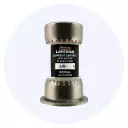 Bussmann JJS Fuses
Bussmann JJS Fuses
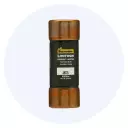 Bussmann JKS Fuses
Bussmann JKS Fuses
Eaton Bussmann Fuse JKS-1 Low Voltage Fuse
Rated 5.00 out of 5In stock
$13.99SKU: JKS-1Brand Eaton Bussmann
Eaton-Bussmann, with its headquarters in St. Louis, Missouri, is a division of Eaton Corporation that specializes in the production of circuit protection products. These products are designed for use in the electrical, electronic, and automotive industries, both domestically and on a global scale. The company boasts a strong manufacturing network with facilities located in three domestic and six international locations, reflecting its commitment to serving customers worldwide. With a team of approximately 3,000 employees, Eaton-Bussmann is well-positioned to meet the ever-evolving needs of its customers in the electrical protection industry.
Eaton stands as a forward-thinking leader in power management, focused on enhancing lifestyles and safeguarding the planet. Leveraging the worldwide momentum of electrification and digital innovation, they propel the global shift towards renewable energy, addressing pressing power management issues on a global scale.Product type Low Voltage Fuse
Voltage 600 Volt
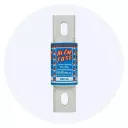 Bussmann KRP Fuses
Bussmann KRP Fuses
Eaton-Bussmann 2 Pole Fuses for 120V Panels Explained
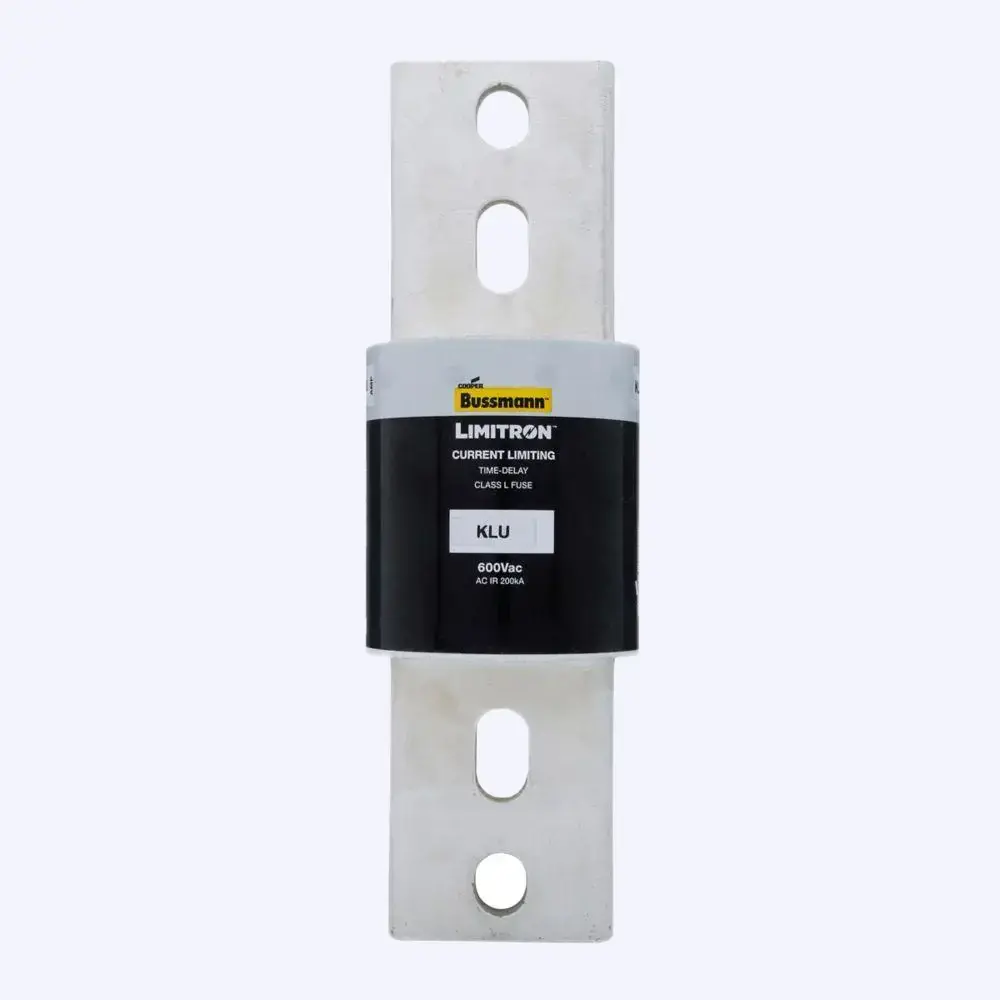
Eaton-Bussmann 2 Pole Fuses for 120V Panels are a crucial component in electrical systems, designed to provide protection against overcurrent conditions. These fuses are specifically engineered for use in 120V panels, ensuring the safety and reliability of the electrical circuit. In this article, we will delve into the product parameters, specifications, uses, and precautions of Eaton-Bussmann 2 Pole Fuses for 120V Panels, providing a comprehensive solution for electrical engineers and technicians.
Product Parameters and Specifications
Eaton-Bussmann 2 Pole Fuses for 120V Panels are designed to meet the stringent standards of the electrical industry. These fuses have a voltage rating of 120V and are available in various ampere ratings, including 1A, 2A, 3A, 5A, 10A, 15A, 20A, and 30A. The fuse elements are made of high-quality materials, ensuring reliable and consistent performance. The fuses also have a high interrupting capacity, which enables them to safely interrupt fault currents and prevent damage to the electrical circuit.
Uses of Eaton-Bussmann 2 Pole Fuses for 120V Panels
Eaton-Bussmann 2 Pole Fuses for 120V Panels are widely used in various electrical applications, including:
- Residential and Commercial Electrical Systems: These fuses are used to protect electrical circuits in residential and commercial buildings, ensuring the safety of people and equipment.
- Industrial Control Panels: Eaton-Bussmann 2 Pole Fuses for 120V Panels are used in industrial control panels to protect against overcurrent conditions and ensure the reliable operation of machinery and equipment.
- Electrical Distribution Systems: These fuses are used in electrical distribution systems to protect against faults and ensure the safe distribution of electrical power.
Precautions and Safety Considerations
When working with Eaton-Bussmann 2 Pole Fuses for 120V Panels, it is essential to follow proper safety precautions to avoid electrical shock or injury. Some of the key precautions include:
- Proper Installation: Ensure that the fuse is properly installed in the electrical panel, following the manufacturer’s instructions and industry standards.
- Correct Ampere Rating: Select a fuse with the correct ampere rating for the specific application, to prevent overcurrent conditions and ensure safe operation.
- Regular Inspection: Regularly inspect the fuse and electrical circuit for signs of damage or wear, and replace the fuse as needed.
- Proper Handling: Handle the fuse with care, avoiding touching the electrical contacts or exposing the fuse to excessive heat or moisture.
Benefits of Using Eaton-Bussmann 2 Pole Fuses for 120V Panels
Eaton-Bussmann 2 Pole Fuses for 120V Panels offer several benefits, including:
- Reliable Protection: These fuses provide reliable protection against overcurrent conditions, ensuring the safety of people and equipment.
- High Interrupting Capacity: The fuses have a high interrupting capacity, enabling them to safely interrupt fault currents and prevent damage to the electrical circuit.
- Easy Installation: The fuses are designed for easy installation, reducing the risk of errors and ensuring a safe and reliable connection.
- Compliance with Industry Standards: Eaton-Bussmann 2 Pole Fuses for 120V Panels meet the stringent standards of the electrical industry, ensuring compliance with regulatory requirements.
In conclusion, Eaton-Bussmann 2 Pole Fuses for 120V Panels are a critical component in electrical systems, providing reliable protection against overcurrent conditions. By understanding the product parameters, specifications, uses, and precautions of these fuses, electrical engineers and technicians can ensure the safe and reliable operation of electrical circuits. With their high interrupting capacity, easy installation, and compliance with industry standards, Eaton-Bussmann 2 Pole Fuses for 120V Panels are an essential component in a wide range of electrical applications.
